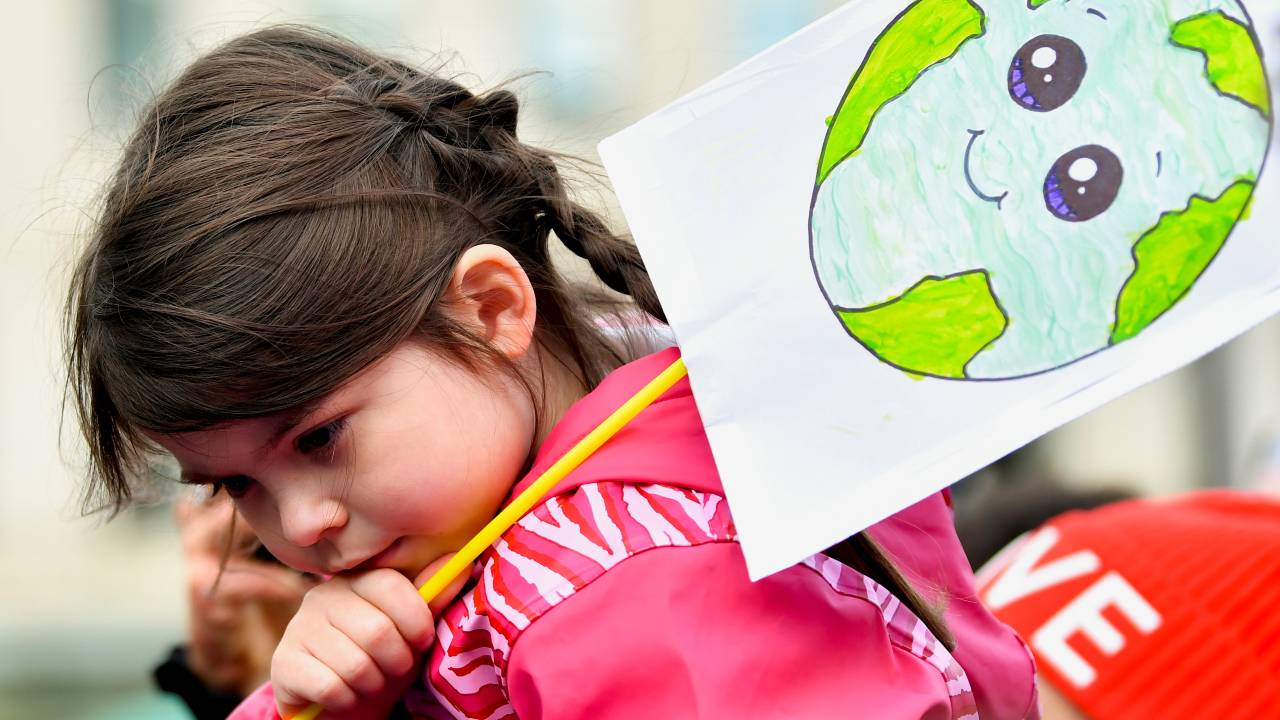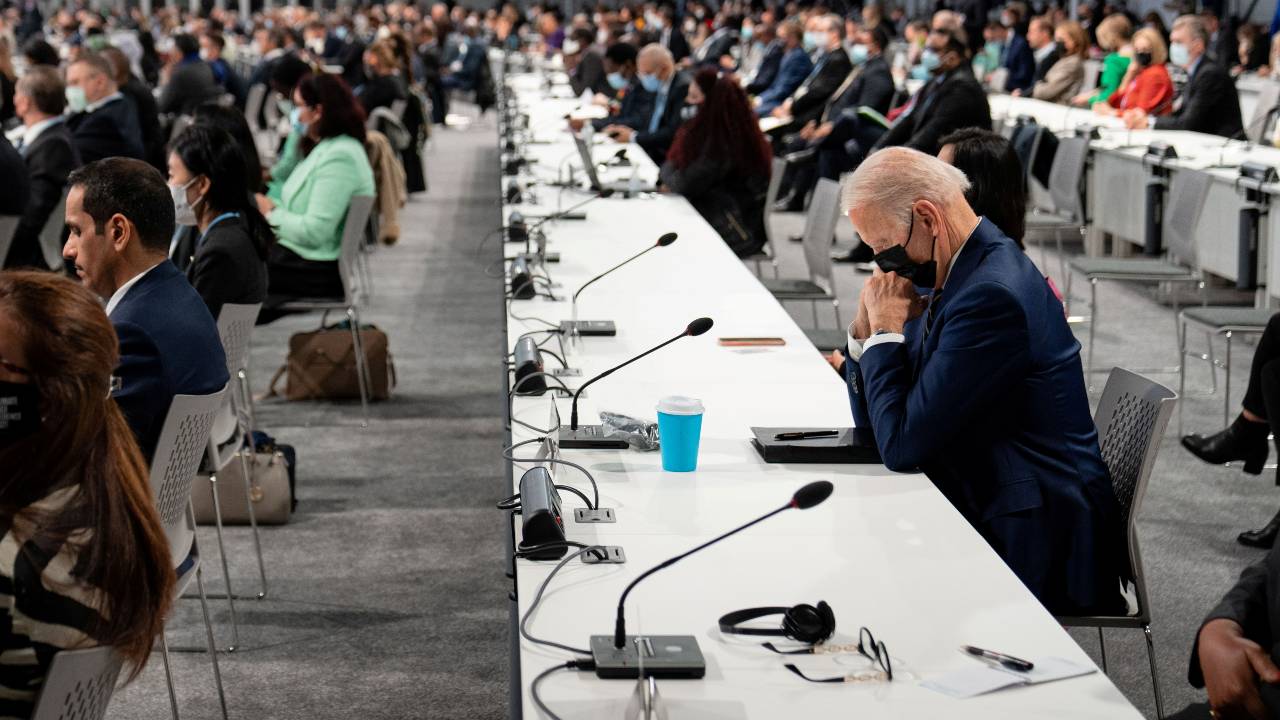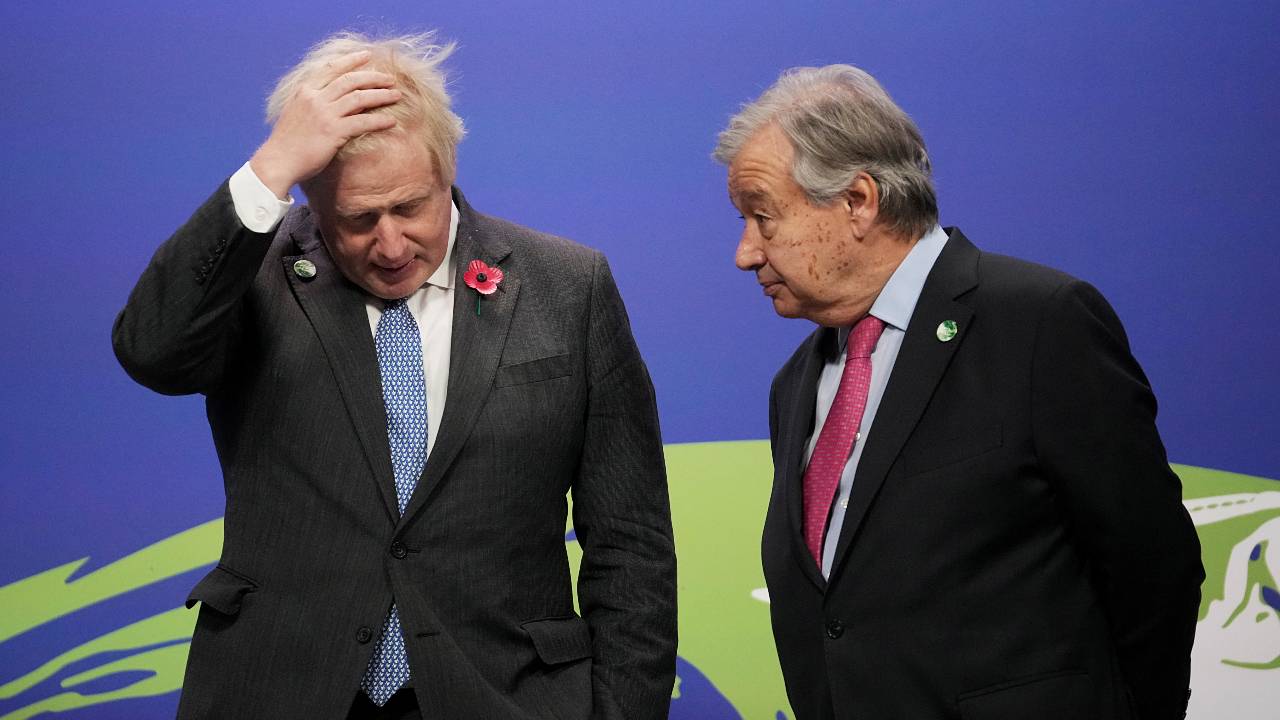The first week of the UN's COP26 summit in Glasgow - billed as the "last, best hope" to save the planet from the climate change's worst effects - has flown by. But what's actually happened at the conference so far?
Here's a round-up of the key events so far.
READ MORE
Can you do the #zerowastechallenge?
Galapagos marine reserve expands
Container crunch boosts Maersk profits

A child holds a placard at the Fridays for Future march during the UN Climate Change Conference in Glasgow. Dylan Martinez/Reuters
A child holds a placard at the Fridays for Future march during the UN Climate Change Conference in Glasgow. Dylan Martinez/Reuters
1) India to aim for net zero emissions by 2070
Prime Minister Narendra Modi got the ball rolling at the summit by pledging that India would meet a target of net zero emissions by 2070. However, that's still two decades beyond what scientists say is needed to avert catastrophic climate impacts.
Modi also said India would push to get half of its energy from renewable resources by 2030, calling on developed countries to make $1 trillion available for climate finance.
2) Biden seeks U.S. return as global climate leader
U.S. President Joe Biden has attempted to use the conference to reassert Washington's climate credibility by apologizing for the decision of his predecessor Donald Trump to pull out of the Paris accord.
"We will demonstrate to the world the United States is not only back at the table but hopefully leading by the power of our example," he said, adding: "I know it hasn't been the case, which is why my administration is working overtime to show our climate commitment is action not words."
Such action has so far included Biden's pledge to cut global methane emissions by 30 percent by 2030, touted as one of the easiest ways to slow global heating.

U.S. President Joe Biden attends the opening session of COP26. /Erin Schaff/Pool via Reuters.
U.S. President Joe Biden attends the opening session of COP26. /Erin Schaff/Pool via Reuters.
3) Global leaders push to end deforestation by 2030
World leaders from 100 countries agreed a deal to end deforestation and land degradation by the end of the decade. A total of $19 billion is set to be devoted to the task, including $1.7 billion for indigenous people. Backers include Brazil, Indonesia and the Democratic Republic of Congo, which together hold 85 percent of the world's forests. China and the US were also among those to sign the Glasgow Leaders' Declaration on Forest and Land Use.
4) China sets out roadmap for climate change contribution
China has used the conference to set out what the world's second largest economy is doing to fight climate change. Setting a goal of peaking carbon dioxide emissions by 2030 and achieving carbon neutrality by 2060, President Xi Jinping's proposals have so far included upholding multilateral consensus, focusing on concrete actions and accelerating green transitions.
5) Finance commits to key climate goals
The shift to green investment has been heralded as a key factor at this year's conference. So far, hundreds of the world's biggest banks and pension funds - with assets worth $130 trillion - have committed to the Glasgow Financial Alliance for Net Zero, which will mean that by 2050, all assets managed by the institutions will be aligned with net zero emissions.
Another accord saw more than 20 countries and financial institutions pledge to stop all financing for fossil fuel development overseas and redirecting an estimated $8 billion a year to green energy. Signatories include the U.S., UK, and some developing nations, such as Costa Rica.

Britain's Prime Minister Boris Johnson and UN Secretary-General Antonio Guterres kick off COP26. /Christopher Furlong/Pool via Reuters
Britain's Prime Minister Boris Johnson and UN Secretary-General Antonio Guterres kick off COP26. /Christopher Furlong/Pool via Reuters
6) End of coal 'in sight'
Nearly 40 countries have now joined a group aimed at ending reliance on one of the dirtiest greenhouse fuels. The new members, many of which rely heavily on coal, include Poland, Vietnam, Chile, Indonesia and South Africa.
The targets range from 2030 to 2040 and beyond, but the growing number of participants has added to existing momentum on cutting coal, even without involvement of the U.S., China and Russia.
7) Developing nations vs. historical emitters on climate bill
Despite the many pledges to come out of COP26, the failure of wealthier nations to meet a 2020 target for providing $100 billion a year in climate financing to developing countries continued to spark anger among developing countries at the summit.
The deal, made at COP15 in 2009, would have seen those most responsible for historical carbon emissions help developing nations deal with the consequences. Now, with many developing countries struggling to investment in clean energy, in part due to a lack of capital, nations like China and India are reminding wealthy historic polluters of their "inescapable moral responsibility" to pay more to avert the climate crisis.

Climate activist Greta Thunberg hits out at the lack of progress made at the summit. /Yves Herman/Reuters
Climate activist Greta Thunberg hits out at the lack of progress made at the summit. /Yves Herman/Reuters
8) Climate protesters pile pressure on world leaders
Thousand of protesters, many of them children, have marched on Glasgow since the start of the summit, demanding that global leaders use the opportunity to commit to real action on the climate crisis.
Climate activist Greta Thunberg, who has been highly critical of the summit since her arrival, slammed COP26 as a "failure" and a "PR event", saying that leaders were "not doing nothing, they are actively creating loopholes and shaping frameworks to benefit themselves and to continue profiting from this destructive system."
9) Cause for optimism?
Despite UN secretary general Antonio Guterres saying that optimistic assessments of progress on climate crisis were "an illusion", the summit hasn't been all doom and gloom. Analysis by the Energy Transition Commission has shown that the commitments and initiatives from the first summit's week - if acted on - would represent 40 percent of the emissions cuts necessary to keep the world on track to a maximum of 1.5C of global heating.
The summit's second week is focused on adaptation - meaning how to deal with a changed climate - and climate change's disproportionate effect on certain countries and communities.
Source(s): Reuters

